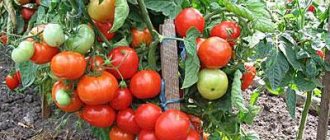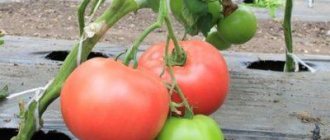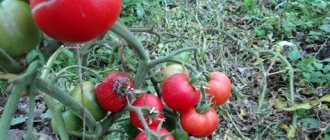The Gazpacho tomato variety looks great: small tomatoes that look like peppers just beg to be put in a jar. But besides preparations, they are also excellent for fresh consumption, because their pleasant taste and juiciness are not inferior to their spectacular appearance.
| Height | Landing location | Ripening time | Fruit color | Fruit size | Origin | Fruit shape |
| short | Greenhouse, Open ground | Mid-season | Reds | Average | Variety | Plum-shaped or oval |
Characteristics and description of the variety
Growing a new variety always raises doubts among summer residents, since they want to get a high yield of tasty fruits. To get rid of many problems, it is better to choose universal varieties. The Gazpacho tomato, thanks to its positive qualities, has gained great popularity among vegetable growers. When getting to know it, it’s better to start with varietal characteristics:
- Tomatoes belong to the determinate type, form a medium-leafed bush, about half a meter high.
- The first fruits appear 2.5 months after seed germination.
- Gazpacho tomatoes are plum-shaped and scarlet in color (see photo). The peel is smooth, glossy. The fruits are sweet in taste, with a delicate aroma. The pulp is fleshy, with few seeds.
- Productivity is high. If agrotechnical rules are observed, 4 kg or more are removed from the bush.
- Keeping quality and transportability are at the highest level, the harvested crop remains fresh and marketable for a long time.
- Gazpacho rarely gets sick and is resistant to unfavorable climatic conditions.
- The variety can grow both in a greenhouse and in open beds.
Since the Gazpacho tomato is not a hybrid, propagation can be done by self-collected seeds.
Features of mid-season tomato
Choosing a new variety always causes some difficulties. Tomato varieties differ in many ways. Growing conditions also leave their mark. Ground tomatoes are much tastier, greenhouse tomatoes are better able to resist diseases, early tomatoes do not always have a rich taste, and late tomatoes often have to be picked unripe in cold summers. But there are universal varieties of tomatoes that save vegetable growers from many problems. “Gazpacho” is on the list of species that remain favorites of summer residents for a long time due to their qualities.
When describing the Gazpacho tomato variety, you need to pay attention to the following characteristics:
- Type of bush. Determinate, low growing, strong, medium leafy. The height of an adult plant does not exceed 45-50 cm.
- Ripening period is average. Tomatoes ripen 115-120 days after germination. A very convenient time for creating a varied menu and culinary preparations.
- Fruit quality. Tomatoes of the Gazpacho variety are cylindrical in shape and rich red in color. Covered with smooth shiny skin. The taste of the fruit is sweet, very pleasant and memorable. The pulp is juicy and fleshy, allowing tomatoes to be used for making aromatic juice. The weight of tomatoes ranges from 75 to 90 grams.
- The productivity of the variety is high. With good care, more than 4 kg of ripe, tasty Gazpacho tomatoes are harvested from one plant (see photo).
- The keeping quality and transportability of the variety deserve the attention of farmers. Tomatoes do not lose their commercial quality for a long time if optimal storage conditions are created.
- Growing method. The Gazpacho tomato variety is recommended for open ground, but many farmers also grow it in greenhouses. The most important thing is that the result does not disappoint.
- The resistance of the Gazpacho tomato to diseases and climatic changes is quite high.
The described qualities of the variety will be very clearly expressed if the agricultural technology for growing mid-season tomatoes is carefully followed, which will be discussed below.
Tea from currant leaves - benefits and harm, preparation for the winter
Similar varieties
Tomatoes are distinguished by shape, taste, bush height, and ripening time. The characteristics closest to Gazpacho tomatoes are the following varieties:
- Stolypin tomatoes are a low-growing, early-ripening variety intended for cultivation in open ground. High-yielding tomato. Red fruits are oblong, weighing 100-120 g, with dense, aromatic pulp. Tomatoes are resistant to diseases and insect pests.
- The Rocket tomato variety is determinate, with uniform yield. The plant is compact, suitable for cultivation in open beds and under film cover. The fruits are plum-shaped, weighing 70-80 g. To obtain a rich harvest, the plant is formed into 2 stems.
- Large plums are low-growing, mid-ripening tomatoes with plum-shaped, red fruits. The pulp is fleshy, aromatic, with a good tomato taste. If you follow agrotechnical rules, you can harvest 5 kg or more from one plant.
Important! Whatever variety is chosen, the main thing is to carry out timely care and prevention of diseases.
Description of the tomato variety Gazpacho with photo
Tomato Gazpacho is a tomato variety bred jointly by the breeding plant and the Research Institute for the Breeding of Vegetable Crops (Russia). In 2010 it was included in the State Register. The variety is recommended for cultivation in the southern regions of Russia - Kuban, North Caucasus, Stavropol. You can cultivate bushes in open ground on personal and farm farms. In the middle zone, this variety can also be grown, but it is better in greenhouse conditions.
Variety characteristics:
- determinant (growth is limited);
- low-growing (bushes no more than 50 cm in height);
- The ripening period is average (from sowing seedlings to harvesting fruits 115-125 days).
The bush grows in height until the moment when a brush with an inflorescence begins to form on the apical shoot. After this, growth stops, so there is no need to specifically pinch the top. The leaves are rich dark green, the tomatoes are medium sized. The flowers are of a typical yellow hue, small, simple inflorescences. The fruits set and ripen together - they can be collected almost simultaneously.
One bunch grows up to 8-10 Gazpacho tomatoes
Attention! The name of tomatoes is associated with the Spanish dish gazpacho. This is a puree soup made from fresh tomatoes and other vegetables. Olive oil, herbs and garlic with various spices are also added there.
Description of fruits
Gazpacho tomatoes have an interesting cylindrical (pepper-shaped) shape, slightly expanding at the bottom. The fruit is orange-red in color with a smooth glossy surface. The skin is dense, which allows them to be stored for a long time and also ensures good transportability.
The fruits of the Gazpacho tomato are small in size, weighing on average from 50 to 90 g, sometimes up to 100 g. Sweet notes prevail over sour ones, so the taste is described as bright and memorable. The pulp is quite juicy and fleshy. At the same time, Gazpacho tomatoes have a pleasant consistency - they are not watery, so the taste is rich.
Important! Although the yield in greenhouses will be slightly larger and the plants easier to grow, the fruits produced in the open ground have a brighter taste.
In appearance, Gazpacho tomatoes resemble bell peppers.
Growing seedlings
To get an early harvest, Gazpacho tomatoes are grown in seedlings. If a young plant
plan to plant on a prepared bed in early June, then the seeds are sown in the last days of March. Very early sowing is not carried out, as the seedlings will outgrow and will take a long time to take root in the new place.
In order for a strong, healthy plant to grow, seeds must be purchased in specialized stores. Planting material is sown in nutrient soil, in plastic cups or low containers.
The seeds are buried 1.5 cm in moist soil, sprinkled with earth and covered with film. The optimal temperature for germination is +23-25°C.
After germination, the shelter is removed and the plant is moved to a cooler, but well-lit room.
After 14 days, the tomatoes need to be picked. To do this, take a large container and deepen the seedlings to the cotyledon leaves. For better survival, plants are shaded from direct sunlight.
Seedling care:
- Good lighting.
- Water with warm water as the soil dries out. Irrigation should be moderate, as waterlogged soil can lead to blackleg.
- The first feeding is 10 days after picking. To do this, use a mineral fertilizer complex, diluted strictly according to the instructions.
- Hardening. 14 days before planting in a permanent place, the tomatoes are exposed to the open air, increasing the exposure time daily.
Important! The seedlings are ready for planting if they have reached 30 cm in height and have 6 rich green leaves.
Features of the fruit
Pepper tomatoes are characterized by a special fruit shape: elongated, cylindrical, sometimes slightly narrowed towards the tip. The characteristics and description of the variety in catalogs indicate the ratio of length and diameter of the fruit as 3:1. The color of ripe tomatoes is bright red, with intense gloss, as can be seen in the photo. Tomatoes at technical ripeness are light green in color, without spots on the stalks.
The skin is strong, but not too thick. Tomatoes are not subject to cracking when ripening, and do not burst during heat treatment during canning. They can be transported without the risk of damage, they retain their attractive appearance and consumer qualities for a long time. When harvested in an unripe state, they can ripen for a long time, remaining until mid-winter.
See also
Description of the Pharaoh tomato and rules for growing the hybrid in seedlings
Read
The pulp is juicy, elastic and dense. The fruit contains 2-3 seed chambers, which contain very few seeds. The thickness of the tomato walls is about 1 cm. Those who planted such tomatoes on their plots characterize their taste qualities as very high and unforgettable.
The increased content of dry substances and sugars makes Gazpacho tomatoes richly sweet, with virtually no sourness. The aroma of tomatoes is characteristic and pronounced. Gardeners note that berries grown in a sunny area display these qualities most clearly.
The purpose of the variety is universal. Tomatoes are good for fresh consumption. Mid-early fruits can be delivered to the table around mid-to-late July, and if grown in greenhouses, a little earlier. Bright slices look beautiful in any salads and cuts. Tomato gazpacho is also prepared from fresh tomatoes.
Tomatoes are ideal for whole-fruit canning: small (70-90 g), elongated in shape, they fit tightly into a jar, and their unusual shape can be effectively combined with assorted pickled vegetables.
Thanks to its good taste and aroma, Gazpacho can be processed into delicious tomato juice and sauces. Small, sweet and dense tomatoes are an excellent raw material for making sun-dried tomatoes. The berries, cut into circles, are frozen so that in winter they can be added to dishes that require fresh tomatoes.
Planting in the ground and caring for tomatoes
A young plant is planted in open ground in the first half of June, after the end of spring frosts. The planting bed is made in a well-lit place, protected from gusty winds. The best predecessors are: zucchini, carrots, legumes and cereals.
Holes are made in the garden bed 20 cm deep. Wood ash is placed at the bottom and the dug holes for seedlings are completely filled with water.
To prevent tomatoes from interfering with each other during growth and development, per square meter. m. no more than 4 bushes are planted. Gazpacho tomatoes are not demanding in terms of care; it involves the following manipulations:
- The first watering with warm, settled water is carried out a week after planting. 2-3 liters are spilled under each plant. During the fruiting period, irrigation should be rare but plentiful, since the taste and size of the fruit depends on this.
- To prevent the formation of an earthen crust after watering, surface loosening is carried out.
- Removing weeds is the main stage in care, since they are carriers of diseases and pests.
- To prevent the bush from breaking off under the weight of the fruit, a support is installed under each stem.
- Feeding with phosphorus and potassium is carried out during flowering and fruit formation. If the seedlings grow and develop poorly, they are fed with nitrogen.
- Since the variety is determinate, pinching is not necessary.
Diseases and pests
The Gazpacho tomato is immune to disease and resistant to attack by insect pests. However, if agrotechnical rules are not followed, the following sometimes appear on tomato bushes:
- Aphids and slugs - after infection, the bush lags behind in development and growth, there is no flowering, fruiting is reduced. To get rid of pests, it is better to use folk remedies: garlic infusion (250 g of crushed garlic is diluted in a bucket of water) or nettle medicine (1 kg of finely chopped nettle is diluted in 6 liters of warm water). After infusion, the solution is filtered and used to treat tomato bushes.
- Late blight and alternaria are dangerous fungal diseases. When infected, dark spots appear on the fruits and leaves. Without timely treatment, the bush dies. To get rid of the fungus, the plant is treated with broad-spectrum fungicides.
In order not to encounter difficulties and to reap a generous harvest, spicy herbs, calendula and marigolds are planted next to the bushes.
Advantages and disadvantages of tomato Gazpacho
According to gardeners, the Gazpacho tomato has many positive qualities. These include:
- high fruiting;
- compact, miniature bush;
- ease of care;
- grows in open ground and under film cover;
- resistance to fungal diseases;
- The period of fruit ovation begins above the 6th leaf, subsequent ones appear through each leaf:
- good keeping quality;
- withstand long-term transportation.
The Gazpacho tomato has no disadvantages, which is why it has gained great love among vegetable growers.
Brief description, outstanding features of the variety
A brief description, its main technical components, important for experienced gardeners who grow various varieties, are that Gazpacho:
- mid-season;
- determinant;
- productive;
- short.
This undemanding tomato variety is ideal for open ground and easily fits into the overall picture of country garden beds. Neat bushes grow up to 50 cm; the stems do not require pinching.











